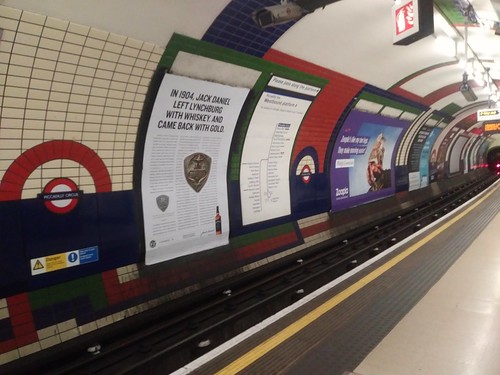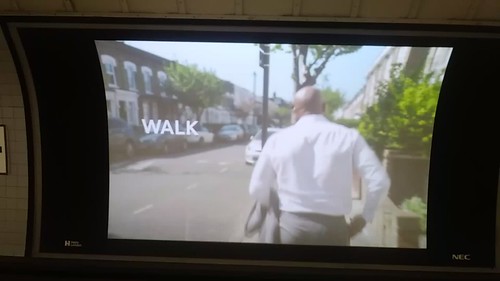Transport for London Walk/Cycle promotion video digital advertising
Besides the German Transport Association model ("The answer is: Create a single multi-state/regional multi-modal transit planning, management, and operations authority association," March, 2017), I use the models of Transport for London and local transit in Paris as the ideal for how transportation planning and operation should be organized at the metropolitan and regional scale in general, especially in the US, especially in the DC area.
While I learned that TfL has its problems (more about that in subsequent posts), spending 6.5 hours including a 4.5 hour walking tour with the former senior product design manager for the TfL bus system, more so than even the examples from Germany (and Austria and Switzerland) ("Verkehrsverbund: The evolution and spread of fully integrated regional public transport in Germany, Austria, and Switzerland," Ralph Buehler, John Pucher & Oliver Dümmler, International Journal of Sustainable Transportation (2018), TfL (and the San Francisco Municipal Transportation Agency) integrate walking and biking and modes other than transit, including roads, within one organization.
In the UK, only London and Manchester (just recently) have this authority. Otherwise things are all bollixed up and made even more complicated because of privatization.
In DC proper, WMATA does rail and bus; DC does some bus + walking and cycling and car share; and the Transportation Policy Board/Metropolitan Washington Council of Governments does transportation demand management programming, as does DC (by contracting with Arlington County).
TfL does all of this in one organization. Plus wayfinding, although arguably that's part of walking and managing the full extent of a journey -- the organization's tagline is "Every Journey Matters.".
But ironically they have the same problem that DC does. E.g., DC does wayfinding. But so does the National Park Service, the Architect of the Capitol, WMATA, and other organizations. The systems aren't integrated.
In London, Network Rail which runs the major train stations has its own wayfinding system. The City of London (a borough) does too. The various royal installations may do different wayfinding schemes. As do various private properties and other large developments.
Typically advertisements (hoardings) are placed on the far wall of Tube stations, and like as in Hamburg or Essen, this can include large digital projection screens, which run advertisements and/or transport-related public service announcements.

Piccadilly Circus London Underground station
I don't remember what station this was from, but I saw the video in a couple different stations. Arguably it could have been longer and they need to do more videos. (Although I think it could be scary to bike in London...) They also have an large number of posters promoting walking that tend to be placed in advertising frames on walls abutting escalators.

==========
This post was sponsored by the donors--anonymous and named, to the GoFundMe account associated with my recent trip to Liverpool and London, which was triggered by my receiving a free registration to the International Place Branding Event one-day conference in Liverpool. Their support is gratefully acknowledged in making this and many other posts possible.
(Donations are still being accepted. Thank you.)
Labels: bicycle and pedestrian planning, provision of public services, public realm framework, urban design/placemaking



4 Comments:
https://tfl.gov.uk/modes/walking/
(You can argue that walking is a very british culture thing, not sure if walking in London is a culture thing.)
Yep, ramblers and all that. I didn't save the obit, but one of the papers that I read on the plane coming back had an obit of , who was key to some of the legal rulings on the right to access to "public roads" (not unlike the battles in California over beach access).
https://www.theguardian.com/environment/2018/apr/11/jerry-pearlman-obituary
(It was just printed.)
2. wrt London, I can hardly say I experienced much of it. A blur. But I think it's not so much culture as utilitarian. Walking is the must effective way to get around in many places. Plus the street environment is just so rich, so much to see. Plus they have so many people that they can support active pedestrian prioritized places.
But hell, Liverpool too. I am gonna write a piece on "what I missed writing from afar" versus being there. Like Essen and other places, they have a pedestrianized center. Liverpool's city budget is low, so they've stinted on maintenance. It wasn't super clean.
But the vibrance of the pedestrian center was amazing. It was a real shocker. Hordes.
Well we get spoiled in DC.
Best city for pedestrians in the US? Maybe Boston. Clearly Manhattan is better but not sure NYC is.
But getting daytime foot traffic in DC outside of CBD is not easy. U st is deserted during the day.
Good point. I wasn't able to check out the pedestrianized center during the day during the week.
But not having as many shopping malls makes a difference. More of the retail remains in High Street districts, which tend to be proximate to transit centers, both of which boost the ability to have a lot of pedestrians therefore pedestrianized areas.
Hackney Central had a pedestrian way with a bunch of shops. Presumably many of the other boroughs do too, outside of course the areas along the River or places like Covent Garden.
Post a Comment
<< Home